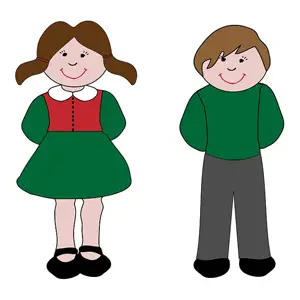Greek Children
 There weren’t any words in the language of the ancient Greeks that had the same meaning as the word “family.” The closest word to family is the word “oikos,” which means household. Oikos means everything that is domestic and includes slaves and servants as well as the members of the family and their household items.
There weren’t any words in the language of the ancient Greeks that had the same meaning as the word “family.” The closest word to family is the word “oikos,” which means household. Oikos means everything that is domestic and includes slaves and servants as well as the members of the family and their household items.
Children were born at home. All the women of the household would be present to ensure the labor was smooth and there may have been a female midwife as well. If there were complications, a male physician may have been brought in for assistance.
Babies frequently died just a few days after birth, so there was generally a waiting period of about a week before a child was named. Since childbirth was considered to be an unclean activity, after the child had survived for a week, there was a purification ceremony and the child was officially named. If the child had some deformity, the father or guardian was in a position to abandon the child, especially if the child was a girl. At times these abandoned babies who had been left outdoors to die were taken in by another family and raised as slaves.

With assistance from her servants and nurse maids, the children’s mother was responsible for their upbringing and care. Mothers and wet nurses breast fed the children and sometimes they were fed from pottery feeding bottles too. The women and children generally lived upstairs in the women’s quarters, called the Gynaikon or Gynaikonitis.
Evidence from vase paintings shows that children slept in cradles that were made of wood or wickerwood. There’s also evidence that babies sat in high chairs and had bottles in the shape of animals. Babies were wrapped up in tight clothing until the age of two years old since it was believed that this is how children’s bones would stay strong and straight. Both brothers and sisters played with their mother in the Gynaikon until they were about seven years old.

Girls in Ancient Greece
Girls were educated at home by their mothers but they were not usually taught to read and write. Their education consisted of how to take care of children and a home. They were also taught how to cook, embroider, and weave.
Girls who lived in Sparta had much more freedom than girls living in other Greek city-states. In Sparta, girls were encouraged to participate in athletics and gymnastics. They also learned music, singing, and dancing.
In most city-states, girls rarely left the Gynaikon and they remained closely supervised by their mothers until they were marrying age. There were special occasions when girls were allowed to attend religious festivals.

After they reached puberty at the ages of twelve or thirteen, girls were considered adults and their fathers arranged their marriages. Often these marriages were to men in their thirties. By taking their childhood toys and leaving them at the temple of Artemis, girls showed that their childhood was officially over.
Once a suitable husband was found, girls were married off and expected to have children of their own. If a family had multiple daughters, it could get expensive since each daughter would have to begin her marriage with a dowry. The dowry was property or money that was given to her husband upon their marriage. Any young women who couldn’t bear children were seen as cursed by the gods.

Boys in Ancient Greece
As in many ancient cultures and some modern cultures as well, boys were favored over girls. Boys were able to continue the family line, care for older parents, and arrange a proper funeral for them when they died.
At age three, a young boy would taste his first sips of wine at the festival of Dionysus. He would also begin to assist at sacrificial rituals to the gods as an official temple boy.
In most city-states, boys lived in the Gynaikon and were trained by their fathers to master different crafts until they were around the age of six. Then they were educated in schools. Spartan boys left their families at the age of seven to be reared and educated by the state for the military. They were not allowed to leave the barracks where they were being trained until they were thirty years of age. Other city-states required boys to join the army when they reached the age of eighteen. They were required to give two years of service.
Rich families had a special slave called a “paidagogos” whose job it was to bring the boys back and forth to school and guarantee that they worked hard while they were there.
Boys learned to memorize and recite poems. They also learned music, reading, writing, and arithmetic using an abacus. Each student used a stylus to write on a wooden tablet that was covered in soft wax. By excelling in athletics, boys prepared to be soldiers by running, jumping, throwing spears and discus, and wrestling in the gymnasium.
Most boys worked hard to become farmers, fishermen, or craftsmen. There were many different kinds of crafts to choose from such as pottery, building, metalworking, or stone carving.



